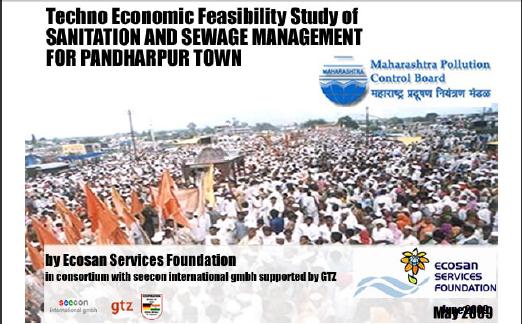Lifestyle
Techno-economic feasibility study of sanitation and sewage management for Pandharpur town, Maharashtra - Ecosan Services Foundation (2009)
Posted on 10 Apr, 2011 02:15 AM This study provides interventions to solving the sanitation crisis in the holy town of Pandharpur, situated on the banks of the Chandrabagha/Bhima river, in the state of Maharashtra, which receives more than 1.5 crore devotees annually. On any given day there are approximately 20,000 pilgrims in this Class B town. This vast floating population creates massive sanitation problems leading to environmental and hygiene issues. The study forms part of the Maharashtra State Pollution Control Board's 'Environmental Improvement Programme at Religious Places in Maharashtra' project.
This study provides interventions to solving the sanitation crisis in the holy town of Pandharpur, situated on the banks of the Chandrabagha/Bhima river, in the state of Maharashtra, which receives more than 1.5 crore devotees annually. On any given day there are approximately 20,000 pilgrims in this Class B town. This vast floating population creates massive sanitation problems leading to environmental and hygiene issues. The study forms part of the Maharashtra State Pollution Control Board's 'Environmental Improvement Programme at Religious Places in Maharashtra' project.
Profile of GUARDIAN microfinance institution
Posted on 31 Mar, 2011 02:19 PMGramalaya Urban And Rural Development Initiatives And Network (GUARDIAN) is a micro finance institution (MFI) and a not for profit institution with no capital, registered under Sec.
3rd Jivan Vidya life-skills workshop, 1st to 6th May 2011, Sirsi, Karnataka
Posted on 28 Mar, 2011 10:56 AMOrganizer: Centre for Holistic Learning
Venue: Huthina Betta campus, Sirsi, Karnataka
India’s water sector: The performance and challenges – A presentation by Himanshu Thakker of SANDRP
Posted on 23 Mar, 2011 11:44 PM The sector is marked by large-scale water development projects like big dams.
The sector is marked by large-scale water development projects like big dams.
Estimating the investment requirements for urban infrastructure services – Report of the High Powered Expert Committee (HPEC)
Posted on 22 Mar, 2011 09:13 AM This report on Indian urban infrastructure and services is an outcome of the High Powered Expert Committee (HPEC) chaired by Isher Judge Ahluwalia set up by the Ministry of Urban Development in May, 2008 for estimating the investment requirement for urban infrastructure services. It is an inevitable outcome of the faster rates of growth to which the economy has now transited. Indeed, urbanisation is itself a process that will support growth. The Committee has made recommendations on how to deal with these challenges of urbanisation.
This report on Indian urban infrastructure and services is an outcome of the High Powered Expert Committee (HPEC) chaired by Isher Judge Ahluwalia set up by the Ministry of Urban Development in May, 2008 for estimating the investment requirement for urban infrastructure services. It is an inevitable outcome of the faster rates of growth to which the economy has now transited. Indeed, urbanisation is itself a process that will support growth. The Committee has made recommendations on how to deal with these challenges of urbanisation.
The Committee has held several meetings with officials from the Government of India, state governments and local governments and also met with academicians and other stakeholders such as Asian Development Bank with interest and expertise in Indian urban issues.
The report argues that the challenge of managing urbanisation will have to be addressed through a combination of increased investment, strengthening the framework for governance and financing, and a comprehensive capacity building programme at all levels of government. The Committee has projected very large investment requirements for providing public services to specified norms and also supporting the growth process. The challenge of financing these investments is inextricably linked with the challenge of governing the cities and towns of India.
Call for Entries – Voices from the Waters 2011, 6th International Film Festival on Water - Last date to apply 15th June 2011
Posted on 16 Mar, 2011 05:23 PMBangalore Film Society in collaboration with Alliance Francaise de Bangalore, SVARAJ, Finger Lakes Environmental Film Festival (FLEFF) of Ithaca College USA, Christ University Bangalore, VISTHAR, Charter of Human Responsibilities, SAMVADA, Karnataka Chalanachitra Academy, YWCA Bangalore and Water Journeys – Campaign for Fundamental Right to Water, are organizing the 6th edition of the largest International Film Festival on Water – Voices from the Waters 2011.
Temple fish sanctuaries: Last bastions of native fish and pristine river stretches - A report
Posted on 01 Mar, 2011 12:56 PM
Temple Fish Sanctuaries: Last bastions of native fish and pristine river stretches
Khazana Bawali - Historical wisdom needing protection - Paper presented at the National Seminar on Water and Culture (2007)
Posted on 14 Feb, 2011 03:57 AMThis paper presents the case of Khazana Bawali - a large ancient well that irrigated around 1000 acres in the past but is now in disrepair. The well is about 20 metres in diameter which stores rainwater from the neighbouring hills. The water is brought through underground tunnels that have ventilators at regular intervals to ensure fresh air and also to help in its manual cleaning. This well today irrigates only about 525 acres. It was built by the Jagirdar of Beed in 1582.






 Rural household saving water at home
Rural household saving water at home